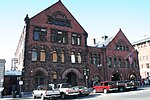Hynes Convention Center station

Hynes Convention Center station is an underground light rail station on the Massachusetts Bay Transportation Authority (MBTA) Green Line. It is located at the intersection of Newbury Street and Massachusetts Avenue near the western end of the Back Bay neighborhood of Boston, Massachusetts. The station is named for the Hynes Convention Center, which is located about 700 feet (210 m) to the east along Boylston Street. It has two side platforms serving the two tracks of the Boylston Street subway, which are used by the Green Line B branch, C branch, and D branch. The main entrance to the station from Massachusetts Avenue leads to a fare lobby under the 360 Newbury Street building. Construction of the station (originally named Massachusetts) began in December 1912; it opened in October 1914 along with the Boylston Street subway for use by the Boston Elevated Railway (BERy). Construction on a surface-level transfer station for streetcars on Boylston Street and Massachusetts Avenue began in April 1918 and was completed the following November. These surface routes were gradually replaced by buses from the 1930s to the 1960s. The transfer station was closed in January 1963 due to construction of the adjacent Massachusetts Turnpike Extension; it was partially demolished. The newly-created MBTA renamed the station Auditorium in 1965, followed by Hynes Convention Center/ICA in 1990 and finally Hynes Convention Center in 2006. A pedestrian tunnel to the southbound bus shelter was opened in 1964, and the Boylston Street entrance was reopened in 1965. Both were closed in the 1980s, though the Boylston Street entrance is still used during the Boston Marathon and major events at the convention center. Averaging just under 9,000 weekday boardings in a 2013 count, Hynes is the busiest non-accessible MBTA station. A renovation to the station, planned as part of air rights development over the adjacent Massachusetts Turnpike, will make the station accessible and reopen the Boylston Street entrance at all times. The project is expected to be completed in 2025 at a cost of $45.7 million. A separate development project is proposed to include restoration of the pedestrian tunnel.
Excerpt from the Wikipedia article Hynes Convention Center station (License: CC BY-SA 3.0, Authors, Images).Hynes Convention Center station
Newbury Street, Boston Back Bay
Geographical coordinates (GPS) Address Website External links Nearby Places Show on map
Geographical coordinates (GPS)
| Latitude | Longitude |
|---|---|
| N 42.3478 ° | E -71.0878 ° |
Address
Hynes Convention Center
Newbury Street 360
02115 Boston, Back Bay
Massachusetts, United States
Open on Google Maps








